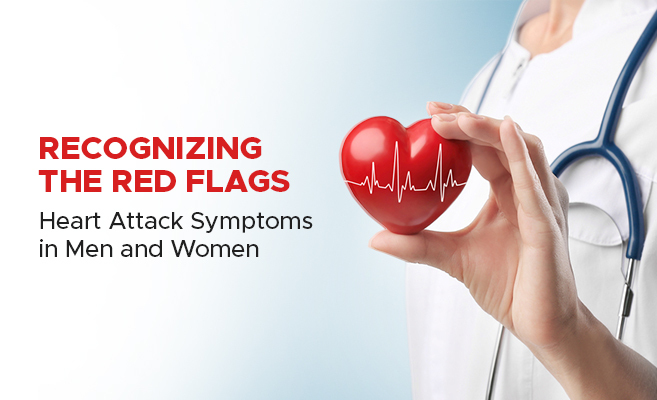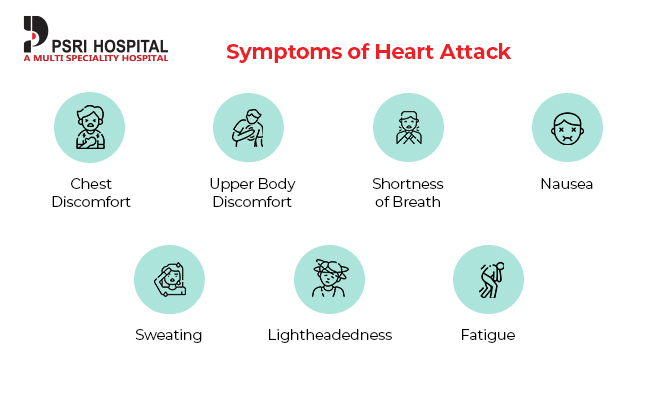Recognizing the Red Flags – Heart Attack Symptoms in Men and Women

Chest pain. Shortness of breath. Discomfort in the arms. These are some of the most common signs of an threatening heart attack. However, symptoms can vary dramatically between men and women. By understanding the differences, you are better equipped to get rapid treatment and potentially save a life. In this blog, we will outline the common causes of heart attacks. We will then explore the wide range of symptoms, with tips on how men and women often experience warning signs differently. Catching these early red flags is important so you can take action right away when a heart attack strikes.
What Causes a Heart Attack?
Before covering the symptoms, it helps to understand what’s happening inside your body during a heart attack. A heart attack occurs when blood flow to part of the heart muscle is severely reduced or completely cut off. This happens because the arteries supplying the heart with oxygen-rich blood can become narrowed or blocked.
Fatty deposits called plaque build-up inside the artery walls over time. This condition is known as atherosclerosis or coronary artery disease. The plaque can eventually rupture, forming a blood clot that blocks the artery. This restricts blood and oxygen from reaching the heart. The medical term for a heart attack is myocardial infarction. Without quick treatment, part of the heart muscle dies from lack of oxygen. Time is truly muscle when it comes to surviving a heart attack with as little permanent heart damage as possible.

Major Symptoms of Heart Attack
Many heart attacks actually start slowly with mild pain or discomfort. This can be easy to ignore at first or brushed off as indigestion or fatigue, especially for women. But paying attention to even silent heart attack symptoms can save your life. Here are some of the earliest symptoms to watch out for:
Chest Discomfort: One of the most common heart attack symptoms in men is feeling pressure, squeezing, fullness, or pain in the center of the chest. It may come and go rather than being constant. The discomfort may be mild at first.
Upper Body Discomfort: You may feel pain or discomfort in one or both arms, the back, shoulders, neck, jaw, or upper stomach area. For example, you might have an unexplained ache in your back between the shoulder blades.
Shortness of Breath: This symptom can be scary if it comes on suddenly. You may start feeling like you can’t get enough air or can’t take a deep breath. Breathing may become uncomfortable or difficult.
Nausea: Some heart attack sufferers experience nausea or an upset stomach in the earliest stages. Vomiting is another common sign for women having a heart attack.
Sweating: Many people with a heart attack break out in a sudden, cold sweat with clammy, moist skin. A feeling of anxiety often accompanies this.
Lightheadedness: Along with difficulty breathing, you may feel dizzy or faint, like you may pass out. Your heart is not pumping sufficient oxygenated blood to your brain.
Fatigue: An unusual feeling of exhaustion, weakness, and lack of energy may indicate reduced blood flow. This symptom is more common among women.
Heart Attack Differences in Women
Now that we have covered the wide range of silent heart attack symptoms, it is important to note some key differences women often experience. Women are more likely to have:
-
- Atypical chest pain – sharp, burning, or “full” feeling.
- Pain in the neck, jaw, back, or abdominal area rather than the chest.
- Nausea, vomiting, fatigue, or dizziness.
- Shortness of breath without any chest discomfort.
Women tend to initially have milder heart attack symptoms, which can lead to missing early warning signs. But don’t dismiss these heart attack symptoms in women; talk to your doctor immediately if anything feels off. The more we understand about gender differences in heart attack symptoms, the better prepared we are to seek timely care. Every second matters when it comes to treating a heart attack.
Conclusion
While chest pain is common, pay attention if you ever experience a combination of these heart pain symptoms, especially if they occur during exertion and get better with rest. Listen to your body and don’t ignore anything that feels “off” or unusual. If you are searching for a top heart surgeon in Delhi or looking for a ‘heart specialist near me’, you are at the right place. PSRI Hospital is a best hospital for heart surgery in Delhi that provide immediate care to stabilize the heart and restore blood flow during a heart attack. Catching it early could save your life. Don’t hesitate to contact us with any heart health questions. We are always here to help you take action quickly when it matters most!
FAQs
What is the difference between a heart attack and cardiac arrest?
Ans. A heart attack is when blood flow to part of the heart muscle is reduced or cut off, causing damage. Cardiac arrest is when the heart suddenly stops beating altogether. A heart attack can lead to cardiac arrest.
What should I do if I think I’m having a mild heart attack?
Ans. If you experience any potential heart pain symptoms, even if subtle, you should seek emergency care immediately. Never try to drive yourself to the hospital. Call emergency services so you can get treated right away.
How can I tell the difference between heart attack symptoms and heartburn or indigestion?
Ans. Heart attack symptoms often feel like pressure or tightness in the chest, along with pain in other areas like the back, jaw, or arms. Heartburn usually causes a burning feeling lower down in the stomach or chest. But when in doubt, get checked out.
Are heart attacks more common in men or women?
Ans. Heart attacks are more common among men over the age of 45. But they pose a significant threat to women, too, especially after menopause. Knowing the subtle symptoms women often experience can save lives.
What is the best way to prevent a heart attack?
Ans. Leading a heart-healthy lifestyle is the best form of preventative care. This includes maintaining a healthy weight, not smoking, limiting alcohol, controlling blood pressure, lowering cholesterol, and staying active.

 Book An Appointment
Book An Appointment Virtual Consultation
Virtual Consultation




